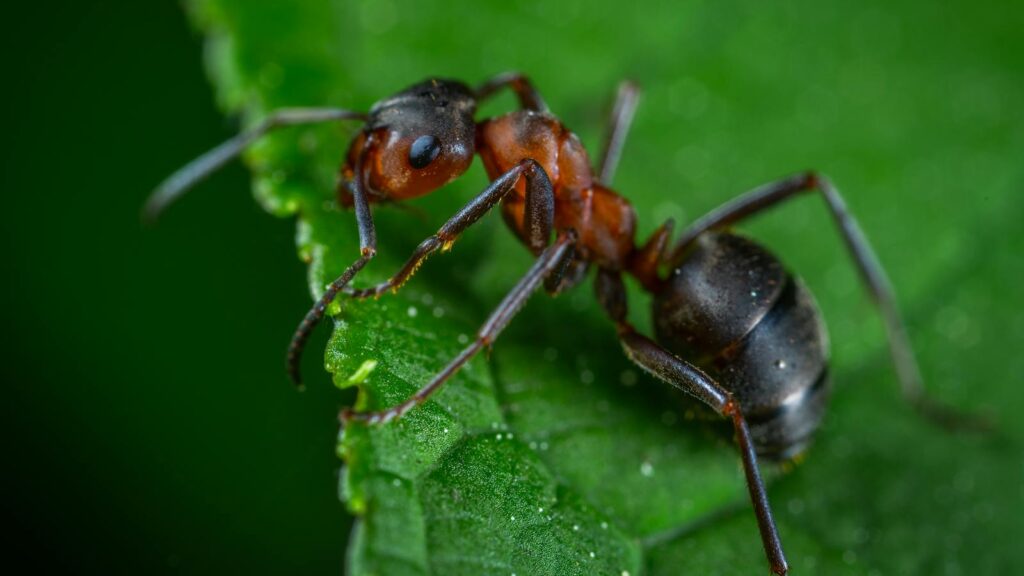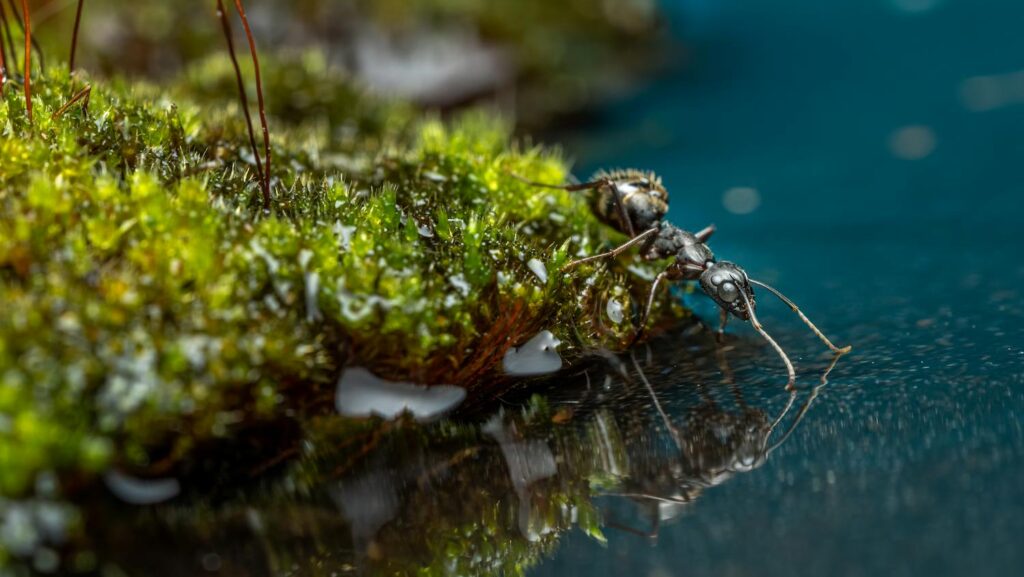
In the vast world of insects, ants stand out as one of the most successful and diverse groups, with over 12,000 known species. While many people picture ants as small, brown, or black creatures scurrying across picnic tables, the reality of ant diversity is far more fascinating. Some ant species have evolved such extraordinary physical characteristics that they barely resemble our conventional image of an ant at all. From bizarre weaponry and elaborate armor to otherworldly shapes and impossible proportions, these evolutionary marvels demonstrate nature’s endless capacity for creative adaptation. This article explores some of the most unusual and visually striking ant species ever discovered, showcasing the extraordinary diversity that exists in the miniature world beneath our feet.
Dracula Ant (Mystrium camillae)
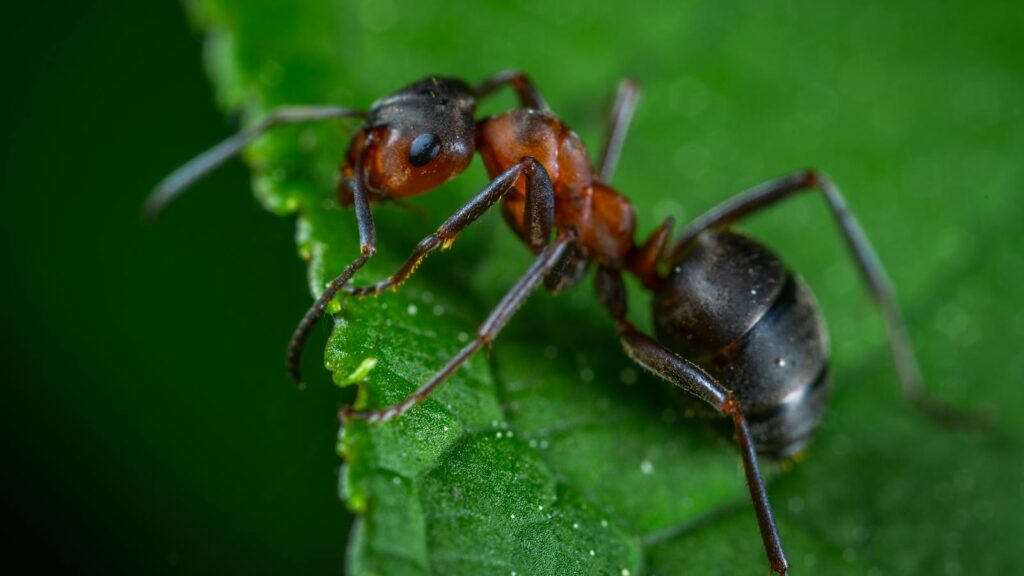
The Dracula ant earns its vampiric name from its peculiar feeding behavior rather than its appearance, though it certainly looks unusual. These ants sport oversized mandibles that snap shut at incredible speeds—the fastest known animal movement on the planet at 200 mph. Their elongated, flattened heads house these powerful jaws, giving them an alien-like appearance compared to typical ants. Native to tropical regions of Africa, Asia, and Australia, Dracula ants have a reddish-brown coloration and possess a distinctly primitive body structure that scientists believe resembles some of the earliest ant species. What truly makes them bizarre is not just their appearance but the fact that adult workers practice a form of non-destructive cannibalism called “non-destructive hemolymph feeding,” where they pierce the bodies of their own larvae to drink their blood.
Trap-Jaw Ant (Odontomachus bauri)

The trap-jaw ant possesses what looks like oversized mandibles that seem completely disproportionate to its body, giving it an instantly recognizable and bizarre appearance. These specialized jaws can open to 180 degrees and snap shut in just 0.13 milliseconds, making them among the fastest-moving anatomical structures in the animal kingdom. The ant’s elongated head has evolved specifically to house the powerful muscles that control these extraordinary mandibles. Beyond just looking strange, these ants can use their powerful jaws as a defense mechanism by snapping them against the ground, launching themselves into the air like tiny biological catapults to escape predators. Native to the Americas, trap-jaw ants have developed this extreme adaptation to become highly efficient hunters, capable of catching prey that would be too fast for other ant species.
Gliding Ant (Cephalotes atratus)

The gliding ant, also known as the turtle ant, has evolved a truly bizarre body shape that makes it look like a miniature armored tank. These canopy-dwelling ants have flattened heads and bodies with shield-like structures that protect them from predators. Their most unusual adaptation, however, is their ability to glide—when they fall from trees, these ants can steer their descent and actually glide back to the trunk rather than falling to the forest floor. Their flat, disc-shaped bodies create lift as they fall, while their legs spread out in a characteristic position that stabilizes their flight. Researchers have found they can turn 180 degrees in mid-air and land on the same tree they fell from, an extraordinary capability for an insect that doesn’t have wings. The flattened head of the worker ants is often used to block nest entrances, creating a living door that protects the colony.
Spiny Devil Ant (Polyrhachis bihamata)
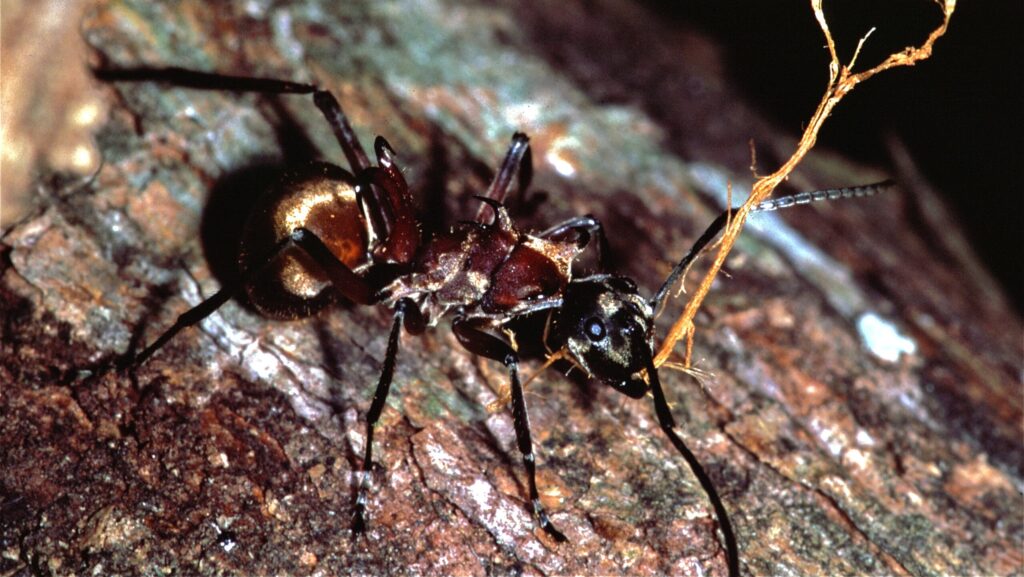
The spiny devil ant looks like it belongs in a science fiction movie rather than in real forests. These ants have evolved elaborate, often intimidating spines that project from their bodies in ways that make them look like miniature medieval weapons. The most prominent spines curve from the ant’s thorax, resembling sharp, backward-pointing hooks that can deter potential predators. Additional spines often project from the head and abdomen, creating a formidable armored appearance that few predators want to tackle. Native to southeast Asia, these ants typically have a glossy black exoskeleton that contrasts dramatically with their sharp, sometimes amber-colored spines. The elaborate defensive structures vary considerably between species in the Polyrhachis genus, with some having more complex arrangements of spines than others, but all contribute to making these some of the most visually striking ants in the world.
Leaf Cutter Ant Soldier (Atta cephalotes)

The soldier caste of leaf cutter ants represents one of the most extreme examples of disproportionate anatomy in the insect world. These specialized ants develop enormous heads housing powerful mandibles and jaw muscles that can account for up to 70% of their entire body weight. The supersized head makes these ants appear bizarrely top-heavy and unbalanced, as if they might tip over at any moment. Despite their fearsome appearance, these soldiers are actually incapable of cutting leaves—their specialized anatomy is purely for colony defense. Their massive jaws can slice through small vertebrate limbs and deliver painful bites to potential predators. The extreme size disparity between these soldiers and their worker nestmates is one of the most dramatic examples of polymorphism within a single species, with soldiers being up to 10 times larger than the smallest workers in the same colony.
Honeypot Ant (Myrmecocystus mexicanus)

Honeypot ants represent perhaps one of the most dramatic physical transformations seen in the ant world, with specialized workers called “repletes” that serve as living food storage vessels. These individuals hang from the ceilings of underground chambers, their abdomens swollen to the size of small grapes with stored nectar and honeydew—sometimes expanding to eight times their normal body size. The translucent, balloon-like abdomen reveals the amber-colored liquid inside, creating an appearance so bizarre that the ants barely look like insects at all. These living storage containers remain immobile, suspended upside-down for months at a time, serving as a food reserve during times of scarcity. Found primarily in desert habitats across North America and Australia, these ants have evolved this extraordinary adaptation to survive in environments where food resources are unpredictable and often scarce.
Dragon Ant (Pheidole drogon)

Named after a dragon from the popular series “Game of Thrones,” the dragon ant sports one of the most unusual physical adaptations seen in the ant world. This recently discovered species has bizarre spines protruding from its thorax that resemble the wings of a dragon, giving it an almost mythical appearance. Native to Papua New Guinea, these ants measure only a few millimeters in length, but their unique protrusions make them instantly recognizable among ant specialists. The spines are believed to serve as attachment points for enlarged muscles that power their front legs, enhancing their ability to carry objects and defend the colony. The distinctive shape of the spines, which curve upward and backward from the middle of the thorax, creates a silhouette unlike virtually any other ant species discovered so far.
Bulldog Ant (Myrmecia pyriformis)
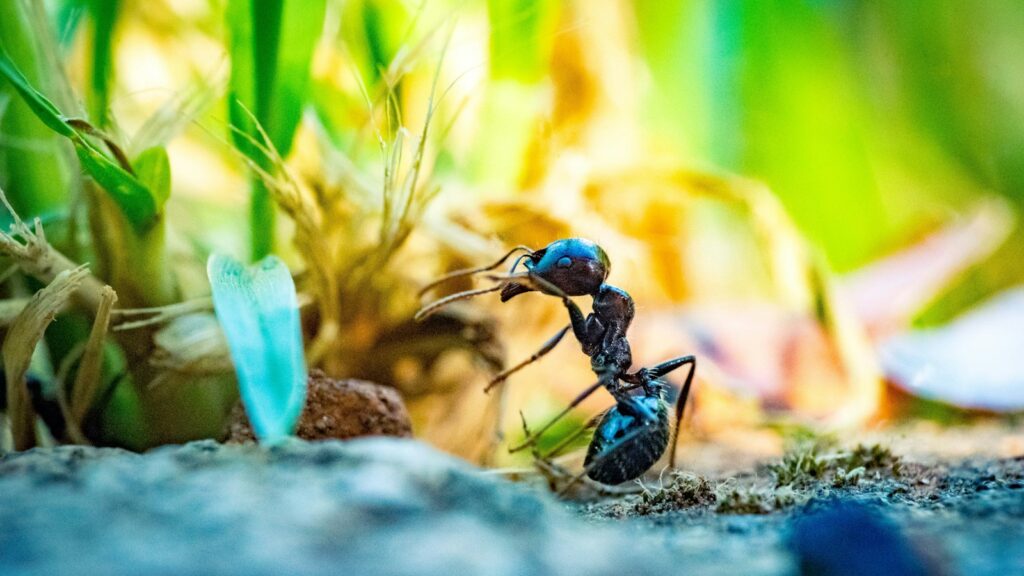
Australia’s bulldog ants are among the most intimidating ant species on the planet, with an appearance that matches their aggressive reputation. These giants of the ant world can grow to over 4 cm in length and possess disproportionately large, forward-facing eyes that give them exceptional vision—unusual in the ant world where many species rely primarily on chemical signals. Their enormous mandibles project forward like the jaws of a bulldog, capable of delivering one of the most painful insect stings known to science. The elongated body and powerful legs allow these ants to make impressive leaps when attacking, sometimes jumping several inches to catch prey or defend themselves. Beyond their fearsome appearance, these ants are also known for their unusual reproductive strategy where virgin queens actually fight each other to the death to establish new colonies—a brutal behavior that matches their aggressive appearance.
Malaysian Exploding Ant (Colobopsis explodens)
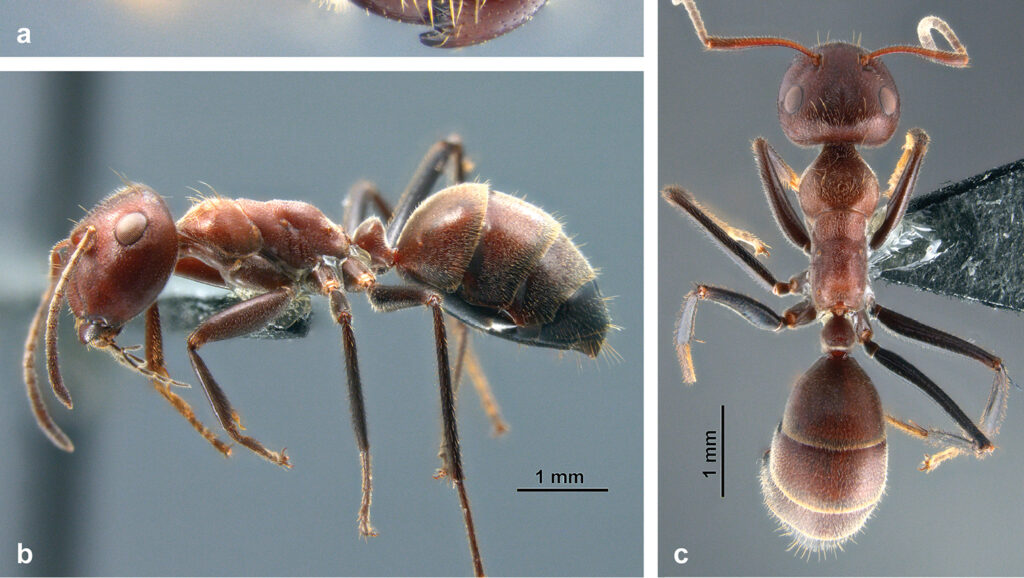
The Malaysian exploding ant has perhaps the most dramatic defensive adaptation in the ant world, which contributes to its bizarre appearance. Minor workers of this species have swollen, translucent abdomens filled with toxic yellow goo that they can voluntarily rupture when threatened, spraying the sticky substance onto enemies in a suicidal defense of their colony. This specialized caste has evolved expressly for this purpose, with glands producing the toxic cocktail taking up much of their abdominal cavity. Their abdomens have a distinctive yellowish tint and bloated appearance compared to other workers in the colony. When threatened, these ants will position themselves near enemies, contract their abdominal muscles violently, and literally tear open their own bodies—a dramatic form of altruistic suicide that protects their nestmates but gives these ants their strange appearance and even stranger reputation.
Arrow Ant (Pseudomyrmex elongatus)

The arrow ant has evolved one of the most unusually elongated body shapes in the ant world, appearing almost like a living needle or dart. These slender ants can be up to three times longer than they are wide, with extremely thin waists connecting their segments to create an unmistakable silhouette. Native to the tropical forests of Central and South America, arrow ants move with remarkable speed along branches and have specialized anatomy for hunting in the canopy. Their elongated bodies allow them to bridge gaps between leaves and branches more effectively, while their unusually large eyes provide excellent vision for tracking prey. Arrow ants often live in mutual symbiosis with certain trees, primarily in the genus Acacia, where they receive shelter and food in exchange for defending the tree against herbivores with their painful stings.
Tractor Ant (Basiceros manni)

The tractor ant earns its nickname from its distinctive body covering that makes it look like a tiny piece of walking soil. These bizarre ants are covered in elaborate hairs, tubercles, and soil-like encrustations that serve as the perfect camouflage in their forest floor habitat. The crusty, uneven texture of their exoskeleton allows them to blend in perfectly with soil and leaf litter, becoming virtually invisible to both predators and prey. Found primarily in South America, these slow-moving ants have evolved to be masters of disguise rather than speed or aggression. Their specialized brush-like mouthparts are adapted for catching tiny arthropods in the leaf litter, while their strange appearance enables them to hunt without being noticed. When disturbed, these ants freeze in place and tuck their limbs close to their bodies, resembling nothing more than a small piece of dirt or debris.
Bizarre Spiked Ant (Acanthognathus teledectus)
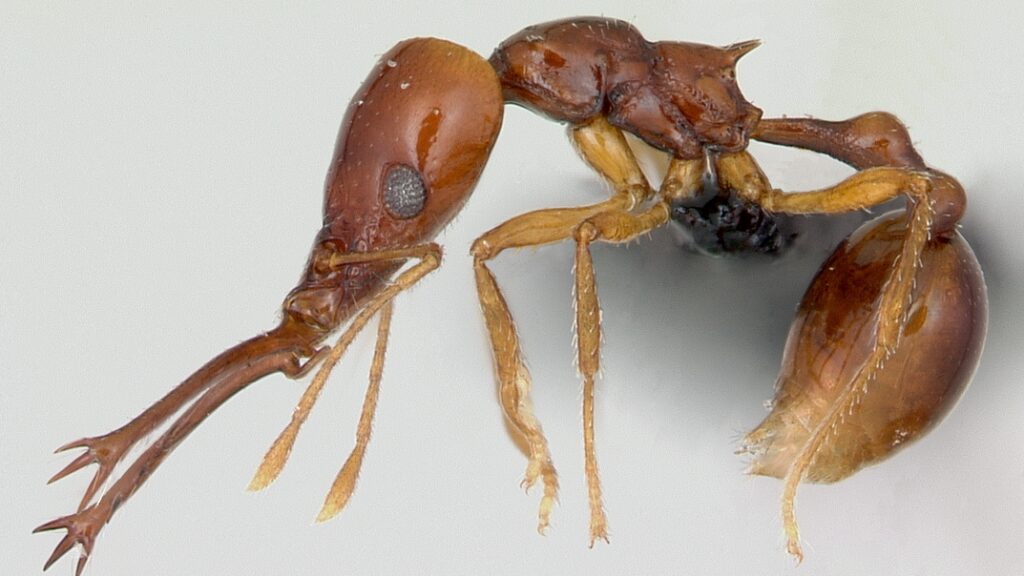
The bizarre spiked ant sports some of the most unusual mandibles in the ant world, resembling elongated tweezers that can extend to nearly half the length of their entire body. These highly specialized trap-jaw mandibles are lined with teeth and trigger hairs that allow the ant to detect tiny prey items like springtails in the leaf litter. Living in the rainforests of South America, these unusual ants have distinctive spines protruding from their heads and thorax, giving them an otherworldly appearance. Their specialized hunting strategy involves holding their oversized jaws wide open while patrolling hunting grounds, then snapping them shut in a fraction of a second when prey touches the trigger hairs. The combination of the disproportionate jaws, spiny projections, and relatively small body create one of the most unusual silhouettes in the ant world.
Parasitic Wasp-Mimicking Ant (Cerapachys sexspinus)

This remarkable ant has evolved to mimic the appearance of a parasitic wasp, creating one of the strangest ant silhouettes known to science. Unlike typical ants, its thorax has evolved a special constriction that creates the visual illusion of a wasp-like waist, while its coloration often includes patterns of yellow and black that further enhance the wasp mimicry. The specialized body shape has evolved as a form of Batesian mimicry, where a harmless species evolves to resemble a dangerous one to deter predators. Found primarily in Southeast Asia, these strange-looking ants move with atypical jerky movements that further enhance their wasp-like appearance. The combination of unusual body proportions, coloration patterns, and behavioral mimicry make these ants nearly unrecognizable as ants to many predators—and indeed to many human observers at first glance.
The Evolutionary Significance of Bizarre Ant Adaptations
The extraordinary diversity of ant morphology showcased in these bizarre species represents the incredible power of evolutionary adaptation. Each unusual feature—from trap jaws to spines, enormous heads to explosive abdomens—has evolved in response to specific ecological pressures and opportunities. These adaptations demonstrate how natural selection can produce seemingly outlandish solutions to survival challenges. For many of these species, their bizarre appearances provide critical advantages in defense, predation, or camouflage that have allowed them to thrive in their respective ecological niches. The extreme polymorphism seen within ant colonies, where different castes can have dramatically different appearances, further illustrates the remarkable plasticity of the ant body plan. Far from being merely curiosities, these bizarre ants represent evolutionary innovation at its most creative, revealing how the process of natural selection can produce forms that sometimes defy our imagination.
The extraordinary diversity of ant morphology represents one of nature’s most impressive showcases of evolutionary adaptation. From mandibles that snap faster than the blink of an eye to living food storage vessels, spines that mimic medieval weapons to ants that explode in self-defense, these bizarre species demonstrate the incredible plasticity of the basic ant body plan. Each unusual feature has evolved in response to specific ecological challenges and opportunities, highlighting how natural selection can produce seemingly outlandish solutions to survival problems. As scientists continue to explore remote habitats and employ advanced imaging techniques, we will undoubtedly discover even more bizarre ant species that push the boundaries of what we thought possible in insect anatomy. These remarkable creatures remind us that even in the smallest corners of our world, evolution continues to create extraordinary diversity that challenges our imagination.

